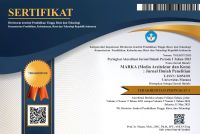Interaksi Manusia dan Lingkungan dalam Kajian Filosofis
Abstract
The study of human and environmental interactions focuses on the symbiotic relationship between humans and the environment. This discussion cannot be separated from socio-cultural aspects that involve cross-disciplinary discussions, such as psychology, anthropology, sociology, social psychology, geography, ethology, and so on seek to find answers to questions about how the environment has been shaped, perceived, used and enjoyed. This study aims to explore the nature of human interaction and the environment. A qualitative method with an explanatory descriptive approach was used to find the philosophical background of human and environmental interactions. Based on the exploration, it was found that human characteristics as individuals or groups play a role in shaping their environment, there are unique mechanisms for connecting humans and the environment, and there is an influence of the environment on humans or vice versa.
Downloads
References
Berman, M. G., Jonides, J., & Kaplan, S. (2008). The Cognitive Benefits of Interacting with Nature. In Association for Psychological Science (Vol. 19, Issue 12). https://doi.org/10.1111/j.1467-9280.2008.02225.x
Burnes, B., & Cooke, B. (2013). Kurt Lewin’s Field Theory: a Review and Re-evaluation. International Journal of Management Reviews, 15(4), 408–425. https://doi.org/10.1111/j.1468-2370.2012.00348.x
Dias, B. D. (2015). Beyond Sustainability – Biophilic and Regenerative Design in Architecture. European Scientific Journal, Special Ed(March), 147–158.
Douma, L., Steverink, N., & Meijering, L. (2021). Health and Place Geographical Life-space and Subjective Wellbeing in Later Life. Health and Place, 70(February), 2–10. https://doi.org/10.1016/j.healthplace.2021.102608
Fekadu, K. (2014). The Paradox in Environmental Determinism and Possibilism: A Literature Review. Journal of Geography and Regional Planning, 7(7), 132–139. https://doi.org/10.5897/jgrp2013.0406
Grinde, B., & Patil, G. G. (2009). Biophilia: Does Visual Contact with Nature Impact on Health and Well-being? International Journal of Environmental Research and Public Health, 6(9), 2332–2343. https://doi.org/10.3390/ijerph6092332
Hartig, T. (2004). Restorative Environment. Encyclopedia of Applied Psychology, 3, 273–279.
Haryadi, Setiawan, B. (2010). Arsitektur, Lingkungan dan Perilaku (1st ed.). Yogyakarta: Gadjah Mada University Press.
Hung, S.-H., & Chang, C.-Y. (2021). Health Benefits of Evidence-Based Biophilic-Designed Environments: A Review. Journal of People, Plants and Environment, 24(1), 1–16.
Jones, M. (2009). Phase Space: Geography, Relational Thinking, and Beyond. Progress in Human Geography, 8(33), 487–506. https://doi.org/10.1177/0309132508101599
Judkins, G., Smith, M., & Keys, E. (2008). Determinism within Human-Environment Research and the Rediscovery of Environmental Causation. The Geographical Journal, 174(1), 17–29. https://doi.org/10.1111/j.1475-4959.2008.00265.x
Kaplan, R., & Kaplan, S. (1989). The Experience of Nature: A Psychological Perspective (1st ed.). Cambridge University Press.
Kellert, S., & Wilson, E. O. (1993). The Biophilia Hypothesis. Washington, DC: Island Press.
Kellert, S. R. (2005). Building for Life: Designing and Understanding the Human-Nature Connection (1st edition). Washington, DC: Island Press.
Kellert, S. R., Heerwagen, J., & Mador, M. (2009). Biophilic Design: The Theory, Science and Practice of Bringing Buildings to Life (1st edition). Hoboken: John Wiley & Sons.
Kellert, S. R., & Calabrese, E. F. (2015). The Practice of Biophilic Design. In www.biophilic-design.com (Vol. 54, Issue 1). www.biophilic-design.com. https://doi.org/10.1063/1.1387590
Kjellgren, A., & Buhrkall, H. (2010). A Comparison of the Restorative Effect of A Natural Environment with that of A Simulated Natural Environment. Journal of Environmental Psychology, 30(4), 464–472. https://doi.org/10.1016/j.jenvp.2010.01.011
Lewis, S. (2012). Technology, Environment, and Society. University of Delaware.
Livingstone, D. N. (2011). Environmental Determinism. In J. A. Agnew & D. N. Livingstone (Eds.), The SAGE Handbook of Geographical Knowledge (pp. 368–380). SAGE Publications Ltd. https://doi.org/10.1093/oso/9780198807117.003.0002
Moran, E. F., & Brond´ızio, E. S. (2013). Introduction to Human-Environment Interactions Research. In Human-Environment Interactions: Current and Future Directions (pp. 1–24). Springer Science+Business Media. https://doi.org/10.1007/978-94-007-4780-7 1
Oana, R., Dirja, M., & Dumitras, A. (2020). Biophilia and Biophilic Design Effects on Quality of Life. Agricultura, 4(3), 291–306.
Pereira, Ma., & Forster, P. M. (2015). The Relationship between Connectedness to Nature, Environmental Values, and Pro-environmental Behaviours. Reinvention: An International Journal of Undergraduate Research, 8(2).
Rapoport, A. (1976). The Mutual Interaction of People and Their Built Environment. A Cross-Cultural Perspective. New York: De Gruyter Mouton. https://doi.org///doi.org/10.1515/9783110819052
Rapoport, A. (1977). Human Aspects of Urban Form: Towards a Man-Environment Approach to Urban Form and Design (1st ed.). Pergamon Press.
Sadeghi, A. R., Ebadi, M., Shams, F., & Jangjoo, S. (2022). Human-Built Environment Interactions: the Relationship Between Subjective Well-Being and Perceived Neighborhood Environment Characteristics. Scientific Reports, 12(1), 1–17. https://doi.org/10.1038/s41598-022-25414-9
Sawitri, D. R., Hadiyanto, H., & Hadi, S. P. (2015). Pro-Environmental Behavior from a Social Cognitive Theory Perspective. Procedia Environmental Sciences, 23, 27–33. https://doi.org/10.1016/j.proenv.2015.01.005
Ulrich, R. S., Simons, R. F., Losito, B. D., Fiorito, E., Miles, M. A., & Zelson, M. (1991). Stress recovery during exposure to natural and urban environments. Journal of Environmental Psychology, 11(3), 201–230. https://doi.org/10.1016/S0272-4944(05)80184-7
Wilson, E. O. (1984). Biophilia. In The Quarterly Review of Biology (1st ed., Vol. 60, Issue 4). Harvard University Press. https://doi.org/10.1086/414572
- Abstract 216
- PDF (BAHASA INDONESIA) 125
Copyright (c) 2024 Anisza Ratnasari, Yohanes Basuki Dwisusanto

This work is licensed under a Creative Commons Attribution-ShareAlike 4.0 International License.







